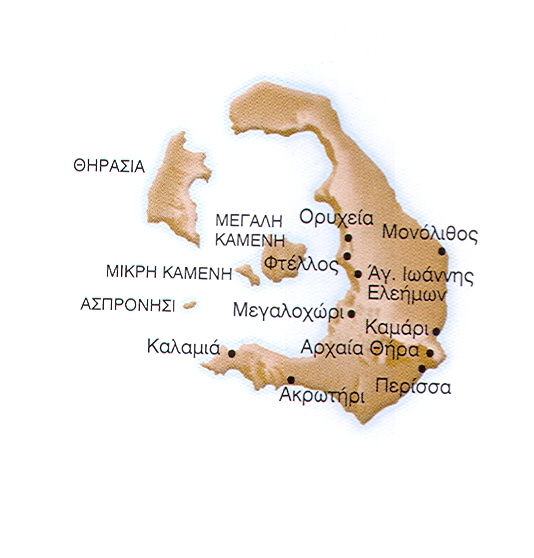THERA
Thera is quite a peticular island of the Cyclades. None less it is the largest southern island is volcanic soil makes it unique.
The first human presence on Thera dates from the Neolithic and come from Akrotiri. This settlement became very important in the Early Cycladic but its exact extent is not know because beneath the later city. Smaller EC site have been found elsewhere on the Island.
On Akrotiri the EC cemetery cemetery mostly chamber tomb was abolished and sometime reuse as storage for the monumental buildings of the Middle Cycladic settlement. Again this phase of Akrotiri is difficult to investigate since it is buried under the ruins of the LC city. At this time was the famous city of Akrotiri, a cosmopolitan port hosting a wealthy community of traders and seafarers. In the mid 17th century a large eruption of the volcano destroyed everything on the island under a layer of ashes (6m meters in places). After this the island was deserted for some centuries until leaving condition was restore. The first indications are the scattered sherds of Mycenaean style around the hill of Monolithos.
In the 8th century Thera was colonized by Lacedaemonians. The centre of the city-state was the on the mount Mesa Vouno at the southeast of the island, but archaeological evidences came from the entire island such as Oia, Eleusis.
Most of archaeological remains came from the cemetery of Oia, Sellada or Mesa Vouno but recently were unearth the sanctuaries of Aphrodite and the Achilleion dating back to the Geometric and archaic period.
Most of the buildings visible at Mesa Vouno date from the Hellenistic and roman period with an acme during the Ptolemaic domination when the amongs others sanctuaries to foreign deities where build.
Most important in later years were the discoveries by the late Charalampos Sigalas of a number of Archaic cult places in the periphery of the ancient capital of Thera. The cult building dedicated to Aphrodite and possibly Eilythia near the ancient town(Ch. Sigalas, Un sanctuaire d’Aphrodite à Thera, Kernos 13 (2000) 241-245), previously considered to have been a tomb, has yielded a multitude of offerings, including several from the East Mediterranean, dating from the Geometric to the Roman period; the Archaic Π-shaped Achilleion at the harbour of Kamari produced mostly drinking vases of the sixth century B.C. (C. Sigalas & A. Matthaiou, Ενεπíγραφα όστρακα από το Ηρώον του Αχιλλέως στην Θήρα, Horos, 14-16, 2000-2002, 259-268). At the necropolis of Sellada a possible Heraion (originally thought to be a Thesmophoreion) of the eighth through fifth centuries B.C. has also been excavated (M. Efstathiou, Θήρα. Αρχαíα Θήρα. Κτíριο Σελλάδας, AD 53, 1998, B’3, 806).
BIBLIOGRAPHY
Dörpfeld, W., T. V. Heldreich, F. Hiller Von Gaertringen & D. Eginitis (eds), 1899. Thera I : Die Insel Thera in Altertum und Gegenwart: mit Ausschluß der Nekropolen, Thera Untersuchungen, Vermessungen und Ausgrabungen in den Jahren 1895-1902, Berlin.
Doumas, C. 2006. Thera: Prehistoric times, Vlachopoulos, A. G. (ed.) Archaeology: Aegean Islands, Αthens, 312-319.
Dragendorff, H. (ed.), 1903. Thera II : Theraeische Graeber, Thera Untersuchungen, Vermessungen und Ausgrabungen in den Jahren 1895-1902, Berlin.
Eustathiou, M. 2001. Το νεκροταφείο της αρχαίας Οίας στη Θήρα, Stampolidis, N. (ed.) Καύσεις στην Εποχή του Χαλκού και την Πρώιμη Εποχή του Σιδήρου : πρακτικά του Συμποσίου, Ρόδος 29 Απριλίου - 2 Μαίου 1999, Athens, 301-320.
Efstathiou, M. 2006. Thera: Historical times, Vlachopoulos, A. G. (ed.) Archaeology: Aegean Islands, Αthens, 320-325.
Pfuhl, E. 1903. Der archaische Friedhof am Stadtberge von Thera, MDAI(A) 28: 1-290.
Sigalas, C. 2000. Un sanctuaire d'Aphrodite à Théra, Kernos 13: 241-245.
Sperling, J. W. 1973. Thera and Therasia, Athens (Ancient Greek cities 22).


